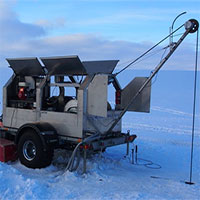What happens when a drop of water the size of the moon falls to the ground? Perhaps this is a question not everyone can think of, but it is very interesting.
First of all we need to know that there are actually “drops of water” the size of or larger than Earth’s moon in space, some of the moons of Jupiter and Saturn, including Europa and Enceladus, but Europa is surrounded by water and ice with rock in the middle, and Enceladus is much smaller than our moon, but its ice and water content is relatively large. In addition, Pluto, once one of nine planets, is smaller than the moon and is also largely made up of water ice.

Europa is the sixth moon, orbiting Jupiter from the inside out. Europa was discovered in 1610 by Galileo Galilei and Simon Marius. These two scientists may have discovered this moon simultaneously and independently. Of the four major moons of Jupiter discovered in 1610, Europa is the smallest.

Enceladus is the sixth largest moon of Saturn. It was discovered by astronomer William Herschel in 1789. Before the 1980s, little was known about Enceladus other than the presence of water on the moon’s surface. Enceladus is about 500 km in diameter, one-tenth the size of Titan, Saturn’s largest moon.
So, what happens when these “drops” fall to the ground? Perhaps a lot of people will think that this is a disaster similar to Earth in the age of the dinosaurs. But in reality, this association is still not quite correct, because the asteroid that hit the ground at that time was only 10km in diameter, and among the above mentioned objects, Enceladus is the asteroid with the greatest diameter. The smallest in size, it has a diameter of more than 500km.
Affected by the acceleration of Earth’s gravity, these giant “droplets” will be accelerated to about 11.2 km/s regardless of how they fall from distant space to the ground, so if a drop of water the size of the moon fell, maybe you can imagine what will happen to us
However, some people may say that these moons and asteroids are not real water droplets, if there are water droplets the size of the moon, they may not occur like natural phenomena. jelly.

In physics, the acceleration due to gravity is the acceleration due to the force of gravity acting on an object. Like velocity, gravitational acceleration is a directional quantity. Neglecting friction due to air resistance, according to the equivalence principle all small bodies accelerated in a gravitational field are the same with respect to the center of mass. This is true regardless of how objects have different masses and compositions.
Even so, what is the difference between asteroids that are purely water at 11.2km/s and other falling objects? The diameter of the moon is more than 3,400km. When water droplets clump together and reach such a large size, they will also take on a spherical shape under the influence of gravity. When they fall to Earth, it is certain that this collision will send a large amount of matter into orbit, perhaps it will be similar to the collision of Theia and Earth in the past.

Theia is the name of a hypothetical planet that, according to the great impact theory of the formation of the Moon, collided with Earth about 4 billion years ago. This collision with the angle of impact was only a slip-on but was enough to destroy Theia, its iron core buried in the primordial Earth.
But there are also some who will assume that such drops will fall to the ground like rain, and maybe it will be a flood. The Earth’s atmosphere is about 80 km high and the diameter of a droplet the size of the moon is 3,400 km, it is certain that this idea is completely unworkable.
In fact, if there are really moon-sized drops of water falling to the ground, what you should do at that time is to pray that there is some mysterious force causing it to fall slowly, not directly. hit at high speed.
However, even so it is probably useless because the volume of the moon is 22 billion cubic kilometers, while the total amount of sea water on Earth is only 1.34 billion cubic kilometers, the amount of water that falls on the Earth land would be 16 times the total amount of water in the oceans so this collision is not simply flooding. It will be a huge amount of water that destroys and engulfs everything. All the land on the Earth’s surface will be washed away. Whether it’s Mount Everest or the entire Australian continent, all the tectonic plates will be crushed and global earthquakes will follow, volcanoes all over our planet will not stop erupting.
Earth’s surface area is just 510 million square kilometers and when a drop of water the size of the moon with 22 billion cubic kilometers of water falls on our planet, that means a 44-kilometer thick layer of water will spread over the Earth’s surface.
The Earth will become a sphere with a surface entirely of water, so earthquake and volcanic activities will only occur underwater. And the surface of the Earth will be relatively still.
For humans, it is estimated that there will be no survivors , and so will other organisms, the survivors may be some microbial plankton in the sea, and all Earth’s living systems will begin to evolve again.

